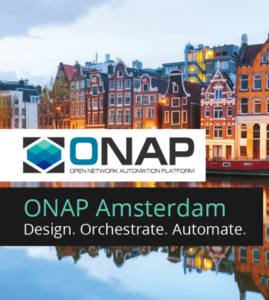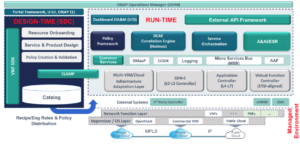Via collaboration of global, sustainable community, ONAP Amsterdam release addresses real-world SDN, NFV and VNFs just in time for 5G
San Francisco, November 20, 2017– The Open Network Automation Platform (ONAP) Project today announced the availability of its first platform release, ONAP “Amsterdam,” which delivers a unified architecture for end-to-end, closed-loop network automation. ONAP is transforming the service delivery lifecycle for network, cable and cloud providers. ONAP is the first open source project to unite the majority of operators (end users) with the majority of vendors (integrators) in building a real service automation and orchestration platform, and already, 55 percent of the world’s mobile subscribers are supported by its members.
“Amsterdam represents significant progress for both the ONAP community and the greater open source networking ecosystem at large,” said Arpit Joshipura, general manager, Networking and Orchestration, The Linux Foundation. “By bringing together member resources, Amsterdam is the first step toward realization of a globally shared architecture and implementation for network automation, based on open source and open standards. It’s exciting to see a new era of industry collaboration and architectural convergence – via a healthy, rapidly diversifying ecosystem – begin to take shape with the release of ONAP Amsterdam.”
The Amsterdam release provides a unified architecture which includes production-proven code from open source ECOMP and OPEN-O to provide design-time and run-time environments within a single, policy-driven service orchestration platform. Common, vendor-agnostic models allow users to quickly design and implement new services using best-of-breed components, even within existing brownfield environments. Real-time inventory and analytics support monitoring, end-to-end troubleshooting, and closed-loop feedback to ensure SLAs as well as rapid optimization of service design and implementations. Additionally, ONAP is able to manage and orchestrate both virtualized and physical network functions.
The entire platform has been explicitly architected to address current real-world challenges in operating tier-one networks. Amsterdam provides verified blueprints for two initial use cases, with more to be developed and tested in future releases. This includes VoLTE (Voice Over LTE), which allows voice to be unified onto IP networks. By virtualizing the the core network, ONAP is used to design, deploy, monitor and manage the lifecycle of a complex end-to-end VoLTE service. The second use case is Residential vCPE. With ONAP, all services are provided in-network, which means CSPs can add new services rapidly and on-demand to their residential customers to create new revenue streams and counter competitors.
“In six short months, the community has rallied together to produce a platform that transforms the service delivery lifecycle via closed-loop automation,” said Mazin Gilbert, ONAP Technical Steering Committee (TSC) chair, and vice president, Advanced Technology, AT&T Labs. “This initial release provides blueprints for service provider use cases, representing the collaboration and innovation of the community.”
Ecosystem Growth Produces ONAP PoCs
With more than 55 percent of global mobile subscribers represented by member carriers, ONAP is poised to become the de facto automation platform for telecom carriers. This common, open platform greatly reduces development costs and time for VNF vendors, while allowing network operators to optimize their selection of best-of-breed commercial VNF offerings for each of their services. Standardized models and interfaces greatly simplify integration time and cost, allowing telecom and cloud providers to deliver new offerings quickly and competitively.
Member companies – which represent every aspect of the ecosystem (vendors, telecommunication providers, cable and cloud operators, NFV vendors, solution providers) – are already leveraging ONAP for commercial products and services. Amsterdam code is also integrated into proof of concepts.
Additionally, ONAP is part of a thriving global community; more than 450 people attended the recent Open Source Networking Days events to learn how ONAP and other open source networking projects are changing network operations.
More details–including download information, white papers, solutions briefs and videos–on Amsterdam are available here. Comments from members, including those who contributed technically to Amsterdam, can be found here.
What’s Next for ONAP
Looking ahead, the community is already beginning plans for the second ONAP release, “Beijing.” Scheduled for release in summer 2018, Beijing will include “S3P” (scale, stability, security and performance) enhancements, more use cases to support today’s service provider needs, key 5G features, and inter- cloud connectivity. Interest from large enterprises will likely further shape the platform and use cases in future releases.
ONAP will continue to evolve harmonization with SDOs and other other source projects, with a focus on aligning APIs/Information Models as well as OSS/BSS integration.
ONAP Beijing Release Developer Forum will take place on Dec. 11-13 in Santa Clara, California, and will include topics for end users, VNF providers, and the ONAP developer community via a variety of sessions including presentations, panels and hands-on labs.
ONAP community members and developers are encouraged to submit a proposal to share knowledge and expertise with the rest of the community: https://www.onap.org/event/submit-a-proposal-for-the-onap-beijing-release-developer-forum-santa-clara-ca
Additionally, ONAP will host a Workshop on “Container Networking with ONAP” in conjunction with CloudNativeCon + KubeCon December 5 in Austin, Texas. The workshop is designed to bring together networking and cloud application developers to discuss their needs, ideas and aspirations for automating the deployment of secure network services on demand. Details and registration information: http://events.linuxfoundation.org/events/kubecon-and-cloudnativecon-north-america/extend-the-experience/mini-summits#ONAP.
About the Open Network Automation Platform
The Open Network Automation Platform (ONAP) Project brings together top global carriers and vendors with the goal of allowing end users to automate, design, orchestrate and manage services and virtual functions. ONAP unites two major open networking and orchestration projects, open source ECOMP and the Open Orchestrator Project (OPEN-O), with the mission of creating a unified architecture and implementation and supporting collaboration across the open source community. The ONAP Project is a Linux Foundation project. For more information, visit https://www.onap.org.
# # #
The Linux Foundation has registered trademarks and uses trademarks. For a list of trademarks of The Linux Foundation, please see our trademark usage page: https://www.linuxfoundation.org/trademark-usage. Linux is a registered trademark of Linus Torvalds.
Additional Resources
Download ONAP Amsterdam
Amsterdam Architecture Overview
Related videos
ONAP Blog
Join as a Member
Media Contact
Sarah Conway
The Linux Foundation
(978) 578-5300
sconway@linuxfoundation.org


 None of this could have been possible without vast support and contributions of time, resources, and passion from across the growing, global ONAP community. Since coming together, ONAP is now comprised of:
None of this could have been possible without vast support and contributions of time, resources, and passion from across the growing, global ONAP community. Since coming together, ONAP is now comprised of: 